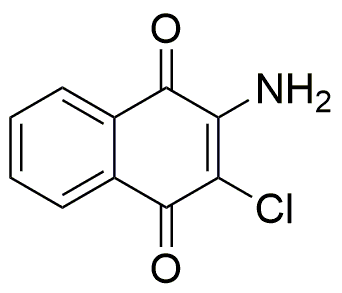2-Amino-3-chloro-1,4-naphthoquinone is widely utilized in research focused on:
- Pharmaceutical Development: This compound is a key intermediate in the synthesis of various pharmaceuticals, particularly in the development of anti-cancer agents due to its ability to inhibit certain enzymes involved in tumor growth.
- Dyes and Pigments: Its vibrant color properties make it useful in the production of dyes and pigments for textiles and inks, providing a stable and long-lasting color that is resistant to fading.
- Biochemical Research: The compound serves as a valuable reagent in biochemical assays, particularly in studies involving oxidative stress and cellular signaling pathways, helping researchers understand disease mechanisms.
- Electrochemical Applications: It is used in the development of electrochemical sensors, where its redox properties allow for the detection of various analytes, enhancing the sensitivity and specificity of the sensors.
- Environmental Monitoring: This chemical can be employed in environmental studies to detect and quantify pollutants, contributing to efforts in assessing and mitigating environmental contamination.
Informations générales
Propriétés
Sécurité et réglementation
Applications
2-Amino-3-chloro-1,4-naphthoquinone is widely utilized in research focused on:
- Pharmaceutical Development: This compound is a key intermediate in the synthesis of various pharmaceuticals, particularly in the development of anti-cancer agents due to its ability to inhibit certain enzymes involved in tumor growth.
- Dyes and Pigments: Its vibrant color properties make it useful in the production of dyes and pigments for textiles and inks, providing a stable and long-lasting color that is resistant to fading.
- Biochemical Research: The compound serves as a valuable reagent in biochemical assays, particularly in studies involving oxidative stress and cellular signaling pathways, helping researchers understand disease mechanisms.
- Electrochemical Applications: It is used in the development of electrochemical sensors, where its redox properties allow for the detection of various analytes, enhancing the sensitivity and specificity of the sensors.
- Environmental Monitoring: This chemical can be employed in environmental studies to detect and quantify pollutants, contributing to efforts in assessing and mitigating environmental contamination.
Documents
Fiches de données de sécurité (FDS)
La FDS fournit des informations de sécurité complètes sur la manipulation, le stockage et l’élimination du produit.
Spécifications du produit (PS)
Le PS fournit une description complète des propriétés du produit, notamment sa composition chimique, son état physique, sa pureté et les exigences de stockage. Il détaille également les plages de qualité acceptables et les applications prévues du produit.
Certificats d'analyse (COA)
Recherchez des certificats d'analyse (COA) en saisissant le numéro de lot du produit. Les numéros de lot et de lot se trouvent sur l'étiquette d'un produit, après les mots « Lot » ou « Lot de fabrication ».
Numéro de catalogue
Numéro de lot/série
Certificats d'origine (COO)
Ce certificat d'exploitation confirme le pays dans lequel le produit a été fabriqué, et détaille également les matériaux et composants utilisés et s'il est issu de sources naturelles, synthétiques ou autres sources spécifiques. Ce certificat peut être requis pour les douanes, le commerce et la conformité réglementaire.
Numéro de catalogue
Numéro de lot/série
Fiches de données de sécurité (FDS)
La FDS fournit des informations de sécurité complètes sur la manipulation, le stockage et l’élimination du produit.
DownloadSpécifications du produit (PS)
Le PS fournit une description complète des propriétés du produit, notamment sa composition chimique, son état physique, sa pureté et les exigences de stockage. Il détaille également les plages de qualité acceptables et les applications prévues du produit.
DownloadCertificats d'analyse (COA)
Recherchez des certificats d'analyse (COA) en saisissant le numéro de lot du produit. Les numéros de lot et de lot se trouvent sur l'étiquette d'un produit, après les mots « Lot » ou « Lot de fabrication ».
Numéro de catalogue
Numéro de lot/série
Certificats d'origine (COO)
Ce certificat d'exploitation confirme le pays dans lequel le produit a été fabriqué, et détaille également les matériaux et composants utilisés et s'il est issu de sources naturelles, synthétiques ou autres sources spécifiques. Ce certificat peut être requis pour les douanes, le commerce et la conformité réglementaire.


